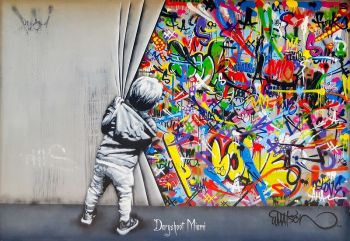Stories that Change Systems

Freya Bradford, Director of Systems Change & Learning
“Stories make, prop up, and bring down systems. Stories shape how we understand the world, our place in it, and our ability to change it.” – Ella Saltmarshe, Telling the Difference
In November, Rotary Charities began piloting a new service for collaborative initiatives working to solve complex community problems, systems change coaching. Coaches with varying expertise - from convening and facilitation, systems mapping, shared governance and decision making, and collaborative fundraising - have been made available to fifteen different initiatives that are taking a systemic approach to address a community issue.
Three months into the eight-month pilot, we have noticed a pattern. Nearly 70% of requests have been for guidance related to communications or storytelling. This piece explores the unique power of story in systems change work and shares some local examples of how initiatives are using story, as well as how and why initiatives remain challenged to use this tool to its full potential.
The demand for storytelling support was surprising on the surface, but after some reflection, it became obvious how vital storytelling is to the success of initiatives that are aiming for large-scale transformation. Storytelling has tremendous worth both internally to build coherence and purpose across diverse actors in a system, as well as strategically to build public understanding, empathy, and belief in the possibility of a different future.
Ella Saltmarshe in her piece, Telling the Difference: Using Story to Change Systems, frames this as the power of story to light (illuminate), glue (cohere), and web (shape mindsets).
Illuminate
Stories help us describe the current state of a problem, the systemic factors creating the problem, what needs to change, and can help us see our role in both the problem and the solution. We can use stories to amplify the voices of those with lived experience with an issue, helping us to build understanding and empathy for perspectives and experiences different from our own.
The Public Will Campaign to End Child Sexual Abuse, a partnership between the Traverse Bay Children’s Advocacy Center and Michigan State University, and one of the first Rotary Charities systems change grantees, sees story as central to their work. Early on, the Campaign’s core team designed a Storytelling Workshop and Our Stories website page for sharing common landmarks around the issue of child sexual abuse to help influence normative behavior. The Campaign also curated literature and media on their website to further illuminate the subject. They have recently been awarded a Rotary Charities Seed Grant to partner with University College Dublin to facilitate book clubs in the region and measure changes in participant awareness, empathy, and willingness to act to protect children. “Despite the prevalence of child sexual abuse, it remains a relatively taboo subject due to its intensely upsetting nature,” notes the Campaign’s Executive Director, Sue Bolde. “Stories help to ease our ‘social flinch’ from engaging with the issue, which positively affects efforts to prevent CSA and to support survivors.”
Another systems change grantee, The Northern Michigan Community Health Innovation Region (CHIR) has recently launched an intensive focus on behavioral health and wellbeing and are using a different type of storytelling device, photographs. The CHIR was awarded a Seed Grant to recruit high school youth to take photographs that depict their perspectives and experiences with mental health and wellness, a strategy called PhotoVoice. The photos will be debuted to hundreds of practitioners and community members at an upcoming Behavioral Health Summit in April, and then will form a traveling exhibit.
Cohere
Transformative change work requires the participation of many people from different parts of a system, often with differing perspectives and experiences. Stories can facilitate the work of convening and connecting people to a shared purpose and each other. Many networks, like the newly formed Sonder, begin meetings with small group connection activities, allowing space for participants’ own stories to emerge, revealing their personal motivations, connection to the work, and place in the system. This type of sharing is more than an ice breaker. As MIT professor Otto Scharmer puts it, it can help the “system sense and see itself,” and allows a group identity and shared understanding to grow over time.
The Northwest Michigan Arts & Culture Network began collecting stories from its members about what they valued about participating in the network, and are now working with a consultant to broaden input from all network stakeholders. The stories are shared internally to help members understand what they are making possible for each other and with the broader communities to build cross sector engagement. They will also begin work with a systems coach to chisel its messaging to better tell its story to all. The network's first work in public will building grew from Arts Midwest's Creating Connection training, resources and findings from national research around public values, behaviors, and attitudes as they relate to arts and culture. Creating Connection is part of a broader effort to use social change strategy to build public will to make arts and culture a more recognized, valued, and expected part of everyday lives.
The Public Will Campaign has taken the additional step of making their personal stories and connections to the work of preventing child sexual assault visible to the public on their website. In this way, the community can also more deeply connect to the people and motivation behind the Campaign and perhaps be inspired to join the effort.
Shape Mindsets
Without even realizing it, we live in a “nest of narratives” that shape how we believe the world works, what is tolerable, and what is possible. Saltmarshe asserts, “If we want to change specific systems, we first need to make mirrors that enable us to see the narratives we currently live by, and then author new narratives that enable the kind of change we want to see in the world.”
Stories can help us see and long for an alternative future, and help us imagine a role for ourselves in building that future.
This power of story, often called Narrative Change, is perhaps its most potent in social change work. As narrative change consultants, Frameworks Institute, shared in a recent report and webinar series, transformative change often requires policy change. Policy does not often shift or endure without significant shifts in public opinion. And public opinion does not change without shifting the popular narrative.
One example that is often cited is the shift in strategy of the Freedom to Marry campaign. When the movement shifted from an equal rights and benefits framing to a frame focused on love, commitment, and freedom, “love is love,” the country saw one of the most rapid swings in public opinion, marriage equality legislation passing in many states, and the landmark 2015 Supreme Court ruling.
Ty Schmidt, Good Works Lab founder, has recently been awarded a Rotary Charities Changemaker Fellowship to learn from and bring the award-winning Frameworks Institute to our region to help changemakers who want to learn how they might use narrative framing to communicate more persuasively about the issues they care about. Look for information on two public workshops this Spring.
Supporting Storytelling
Even with storytelling such an influential practice in social change work, it remains sorely under-supported and under-resourced, and thus can be very challenging. Systems coach Jessica Conrad has been focusing her time in the pilot on communications and storytelling and shares, “We need to help people—especially those in a position to support this work—see the tremendous value of storytelling as a systems change strategy. How to create and share more impactful stories of change is a field-level challenge, and solving it will require an investment in our collective creativity and imagination." Initiatives are reaching out to the pool for assistance with:
- Bridging systems change work with the human stories of those who will ultimately benefit: The focus of systems change work is typically on the structures, practices, and mindsets that influence how a system behaves and this can feel very removed from the ultimate purpose of the work – to make systems work better for all. Coaches have been helping initiatives uncover and illuminate how their work will ultimately help real people through exercises like Nine Whys and Empathy Mapping.
- Holding space for initiative participants to share their own stories: Personal storytelling requires trust and vulnerability, which can take time and care to develop. Coaches are helping initiatives with ideas of how to add connection activities into meeting agendas that ease participants into getting to know one another, and make more visible what holds them all together.
- Developing a common narrative: It can be difficult to talk about systems change work because it is complex, is not business as usual, and often involves the work of many different players. Coaches are working on helping several initiatives to develop a Common Narrative to serve as the frame that all other stories can hang on. A common narrative can allow diverse storytelling to emerge from across a system, and still harken back to the shared purpose of the work for the audience (a sort of hash-tag effect).
Storytelling alone will not change entrenched systems, but it is a powerful tool worthy of greater intention and investment. We look forward to learning and sharing more about how coaching may help initiatives tell stories that illuminate, cohere, and shape mindsets.
Look for us to follow Changemaker Fellow, Ty Schmidt, on his storytelling journey with the Frameworks Institute this spring, including two workshops that will be open to the public.
Freya Bradford is the Director of Systems Change and Learning at Rotary Charities of Traverse City. You can reach her at fbradford@rotarycharities.org
Photo: Daryshoot Miami, Behind the Curtain, Martin Whatson, Wynwood Walls, Miami Florida



